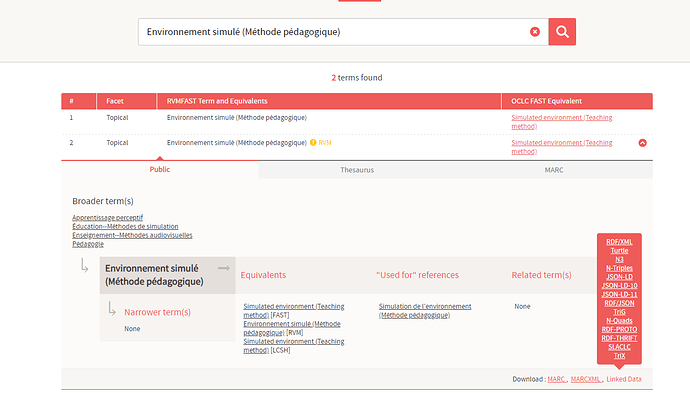After years of dabbling, I’m still very naïve about LOD. Which means that this is a difficult question for me to phrase.
How do I import (some of) RVM FAST’s authority records?
What I’m Trying to Do
In a proof of concept for a repository bringing together free digital learning resources (including Open Educational Resources), I’d like to demo the use of controlled vocabularies with which people in Quebec’s Higher Education network are familiar. RVM is the key source for such controlled vocabularies.
In the end, what I’m expecting is an easy way to consistently assign subject headings to learning resources (and these SHs would come from those vocs). As far as I can tell, this is something which makes Omeka S shine. If that part of the proof of concept, it could put Omeka S ahead of other solutions.
Context
RVM («Répertoire de vedettes-matière» aka “Repertory for Subject Headings”) produces a set of thesauri which are widely used in Quebec. It’s a bit like LCSH for Quebec. Though these thesauri are closed (and typically distributed as MARC), the team has been working on LOD versions in open access.
There’s already a beta of an open access version based on OCLC’s FAST (Faceted Application of Subject Terminology). That’s the aforelinked RVM FAST. It uses the same core LOV as the closed RVM does. Compared to RVM, RVM FAST is meant to become simpler to use for non-librarians (myself included).
Where We’re At
After some interactions with the RVM team, and collaborating with them on solving a bug, I’ve successfully imported RVM’s core vocabulary (currently in beta).
I can find and download Linked Data files for specific records in RVM FAST.
Available formats:
- RDF/XML
- Turtle
- N3
- N-Triples
- JSON-LD, JSON-LD-10, JSON-LD-11
- RDF/JSON
- TriG
- N-Quads
- RDF-Proto
- RDF-Thrift
- SLACLC
- TriX
Now, What?
The next step would be to import records using that core voc I’ve imported.
What do I do with that .ttl (or .nt, .trix…) file? Where do I put it so that it’s available in a resource template for new items?
As you probably understand, I realize that I might be off at a fundamental level. At the same time, it feels like we’re close to that (intermediate) goal.
Any help would be deeply appreciated.
